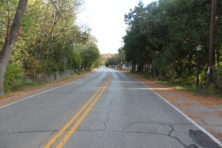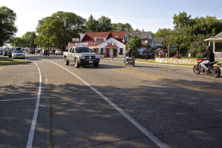Ephraim Streetscape Plans Hit ‘Dead End’
- Share
- Tweet
- Pin
- Share

The Department of Transportation responded to Ephraim’s proposed plans for the Hwy. 42 resurface project with changes that could lead to a complete overhaul of a project that began in 2014. The village is now working against the DOT’s Aug. 1 deadline to decide on priority infrastructure, including stormwater management.
“This whole thing has been set on its ear,” said Mike McCutcheon, president of the village board. “We’ve moved slowly on this and we may have come to a dead end.”
Village officials and their engineers at AECOM have been working off of minimum standards set by the DOT on the highway resurface project. The village submitted its 30 percent plans to the DOT based off of these minimum standards, but on May 24 the village heard the DOT would be requiring more than its minimum standards.
One restriction is in the width of driving lanes.
The village squeezed its planned cross section of the highway design under the assumption of the DOT’s minimum 11-foot wide lanes. After plans were submitted, the DOT came back to say the lanes must be at least 12 feet due to federal standards for trucking routes.
“That was the first time [trucking routes] ever came up in conversation,” said Village Administrator Brent Bristol. “[DOT] said that while the 11-foot might be minimum on paper, this truck route kind of negates that… The board will take a step back and reevaluate what that will mean.”
According to McCutcheon’s conversations with engineers, it means the portion of the highway footprint south of German Road will be expanded, likely resulting in cutting down trees along the corridor.
The second blow to Ephraim’s plans deals with the unanimously favored stormwater management.
Most preliminary plans put together by village officials with public comment included a curb on the east side of the highway. The west side of the highway along the water would be kept as it is.
“From German Road south, the desire was to have curb and gutter facilities on the one side of the road to facilitate having that walking path but on the other side maintain the existing condition on the highway,” said Bristol.
The DOT said if the village wants to implement a stormwater management plan, they will require curbs on both sides of the highway.
Board member Tim Nelson said at the village’s May 16 meeting that if the details on the streetscape project was scrapped, they would still do some stormwater management.
“You’re not going to get that without curbs on both sides,” said McCutcheon. “They have to be on both sides to direct the water. That’s what we got from the DOT.”
AECOM estimated that curb and gutter on one side of the highway would cost $117,000. An additional curb and gutter on the other side could double those costs, which would be required if the village pursued stormwater management at an estimated cost of $404,700. Village officials expect the DOT to pick up the cost for the resurface, estimated at $787,000.
These potential additional costs come at a time when Ephraim residents are already concerned with increased tax rates to pay for the project.
“These changes affect a small area of the village geographically along State Hwy. 42 but they also affect all Ephraim residents and taxpayers in every part of the village,” said Dick Van de Ven. “Not only the full-time residents but also the seasonal property owners, residential and business, without a vote and therefore perhaps less of a say in what actions the village board would decide to do tonight to increase their taxes.”
Van de Ven added that stormwater management was still a priority and necessary expense. He made these statements before learning of the DOT’s response to the proposed plans.
The village board will now go back to its engineers to explore costs associated with stormwater management at the south end of the village.
“Here we are having spent almost three solid years and a hell of a lot of work on the board’s part, on your part… and here we are,” said McCutcheon.
The DOT requires Ephraim to financially commit to its plans by Aug. 1. While the village can still modify its plans after that deadline, it must commit to big ticket items such as stormwater management, utility line burial and walking paths by that date.


